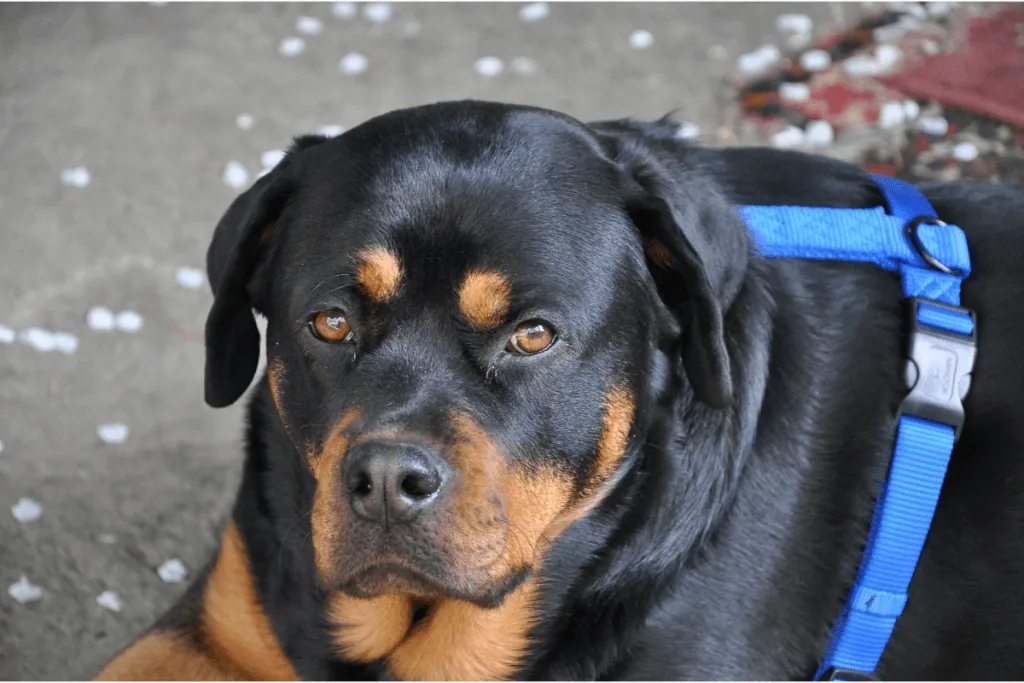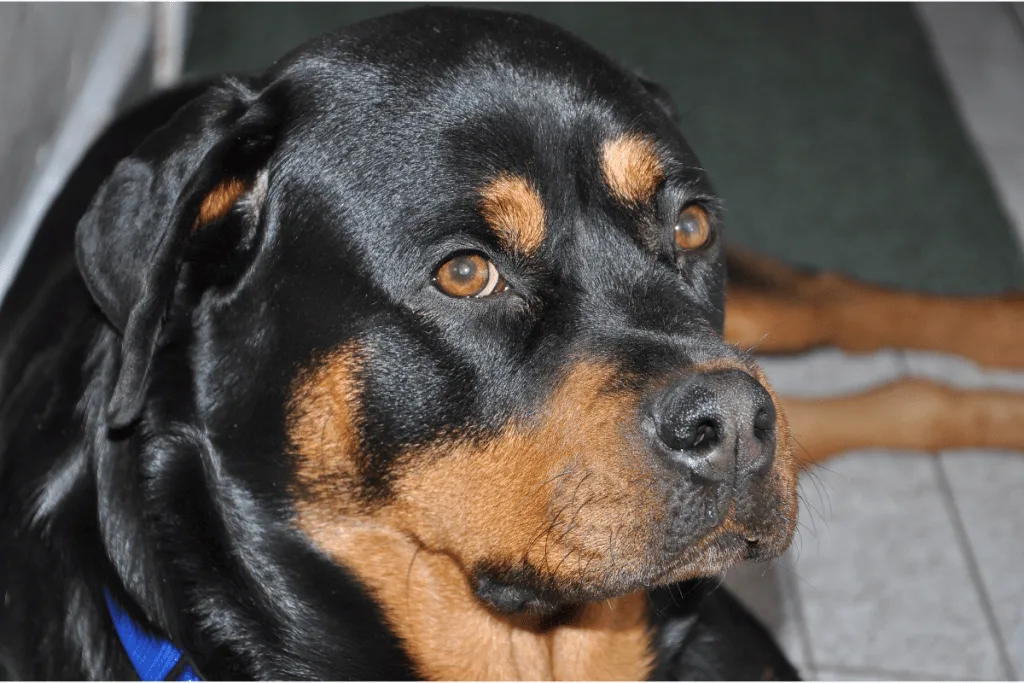The decision to welcome a new pet to your family is an important one. If you are looking for a hundred-pound cuddle partner, a Rottweiler might be one of your considerations.
So, do Rottweilers like to cuddle and be affectionate?
The American Kennel Club summarizes Rottweilers to be loyal, loving, and confident. The breed is known for being friendly towards people they know well but indifferent towards strangers. Owners describe their Rottweilers as devoted, affectionate, playful, and protective of their families.
Dogs have an inherent need to be loved and, in return, to give love – and Rotties are no different.
However, factors such as temperament, personality, history, and training may influence certain behavioral traits of a dog.

Click Here to Jump to a Section
Do Rottweilers Like to Cuddle?
While most owners would agree that their Rottweilers love nothing more than to snuggle in for a cuddle, some Rotties just don’t like to.
It is nothing personal; it boils down to unique personalities, past experiences, and in some instances, even the environment.
Personality
While some dogs are just giant cuddle bugs, others might need a little more space.
Think of it the same way as introverts vs. extroverts; it is the same basic principles.
Unique personalities are often the leading influence for interactive expressions in dogs; this means that while one Rottie will nap on your lap, another might just need to be in the same room as you to be happy.
Age
Younger dogs that need a lot of attention can be more open to cuddles, whereas senior dogs might give up the lap climbing and just want to be close to you.
But once again, you might find that opposite to be true in your case.
Past experiences
Another aspect that can determine a Rottweiler’s snuggle needs is how they grew up and where they grew up.
For example, if you have a rescue Rottie that used to live outside, it might be that they are just not used to cuddle time on the couch.
Give it some time to gain their trust and show them just how wonderful cuddles can be.
Environmental factors
Seasonal changes might have an impact on cuddle time as well. Summer vs. winter; it can be as simple as that.
Your Rottie might not want to be cuddled on a ridiculously sweltering day and, on the other hand, want more cuddles on colder days – they might be dogs, but they have a lot in common with humans.
Are Rottweilers Affectionate?
Rottweilers are very affectionate and make great family pets.
Having years first-hand experience with Rottweilers, I can attest to their sweet and loving temperaments.
Rottweiler Temperament Summary
Rotties are playful and friendly towards kids and friends, and they adore their owners but might be just a little wary of strangers.
They were commonly used as police dogs because of their sharp wit and excellent ability to follow commands, which means that training should not be a hardship.
You may also like: Why Are German Shepherds Good Police Dogs?
These traits are a typical result of responsible breeding.
While training and socialization go a long way to keep your dog on its best behavior, irresponsible breeding can contribute to variables in general temperament expectations. It is best to make sure you get your pup from a respectable breeder.
Related: Should I Adopt a German Shepherd From a Shelter or Buy One From a Breeder?
How Do Rottweilers Show Affection?
Rotties will show affection in diverse ways; as stated earlier, unique personalities are often the dominant factor for behavioral traits in dogs, regardless of the breed.
Some dogs will show affection by sitting with you, on top of you, or leaning up against you.
If you get a sloppy kiss from your Rottweiler, that is the ultimate sign of affection in the canine world.
Head bumps or pawing at you translates to the need for rubs and scratches.
Another way some Rotties show their love is by purring. If you are thinking along the lines of a soft, soothing purr of a kitten, you might be in for quite the disappointment; think more like a growling tiger than a purring feline.
How to Show Your Rottie Love

You can do a few things with your furry friend to show your affection and create a strong bond between dog and owner:
- Spend time with your Rottweiler
The time you spend with your dog is the most valuable thing you can give them; they feel loved and cared for, resulting in a calmer and happier pet.
- Doggy massage
Give your pup a nice rub-down after playtime (or before bedtime); not only does this feel good to your Rottie, but it helps to reduce anxiety and promote good circulation.
- Body language
Take note of how your Rottweiler reacts in certain situations; if your pet feels uncomfortable with something, try to avoid it. It would make them happier.
Why Do Rottweilers Growl When Snuggled – and What Does it Mean?
Rottweilers make sounds while being petted, the so-called Rottie purr or Rottie rumble.
While it might sound a little mean, it is just their way of communicating their happiness.
The growling might come across as a “warning” to a person unfamiliar with the Rottweiler temperament.
The important thing is knowing your dog and why they are growling – Rotties purr or rumble when they are happy, receiving attention, giving kisses, or greeting.
But sometimes, the growl might have a different meaning (this is why learning your dog’s body language is essential).
Rottweilers can also growl to display dominant behavior, pain, fear, or aggression.
Many dogs show signs of hostility when they are scared and feel they need to protect themselves. You can learn more about the various types of aggression in dogs by reading this article by the ASPCA.
Just take a look at the videos below for some examples of this – especially the second video “Growling Rottweiler Kisses”!
Busting the Myth That Certain Breeds Are Prone to Aggression
While researching whether a Rottweiler will be a good fit for your family, you might come across people who mistakenly believe that this breed is prone to aggression.
While Rotties have an inherent protective nature, this should never be confused with being aggressive.
And on the other hand, even if your dog is placid and enjoys a good cuddle, owners must understand that their Rotties are guardians.
The Importance of Early Socialization and Obedience Training
Early socialization with dogs (and humans) is crucial.
As soon as your pup has received all the necessary shots – which would be around three or four months old – take them on walks in the neighborhood to meet other people and dogs.
The next step is puppy classes, where they can learn how to interact with other dogs while setting the foundation for advanced training as they get older.
Advanced obedience training will be beneficial to ensure that your Rottie knows when to engage and disengage.
It goes beyond learning fancy tricks; some owners believe this as a necessity. Rottweilers are intelligent dogs and highly trainable if you take the time with them.
Powerful Breeds and the Need for Voice Commands
Rottweilers are one of the strongest canine breeds (among breeds like German shepherds, Siberian huskies, and Mastiffs).
Related: Ever Wonder Why Rottweilers are so Strong?
Because they are also protectors, owners have to keep in mind that controlling a powerful breed can become tricky sometimes.
Dogs feed off of human emotions. If you are scared, your dog senses your mood changes and will react to those changes.
A few dogs will choose flight over fight, but most Rottweilers are likely to face the danger head-on. It would help if you had a way to control your Rottie with voice commands when the need arises.
Final Thoughts
Rottweilers are great companion dogs because of their affectionate and playful personalities.
Keep in mind that dogs have unique personalities and might not show their affection with cuddles but use other means to let you know they love you.
It is, however, very important to understand the difference between a growl of affection and one that my be signaling fear or discomfort.
The best way to understand such differences is get to know your individual dog by spending lots of time with him and paying close attention!
